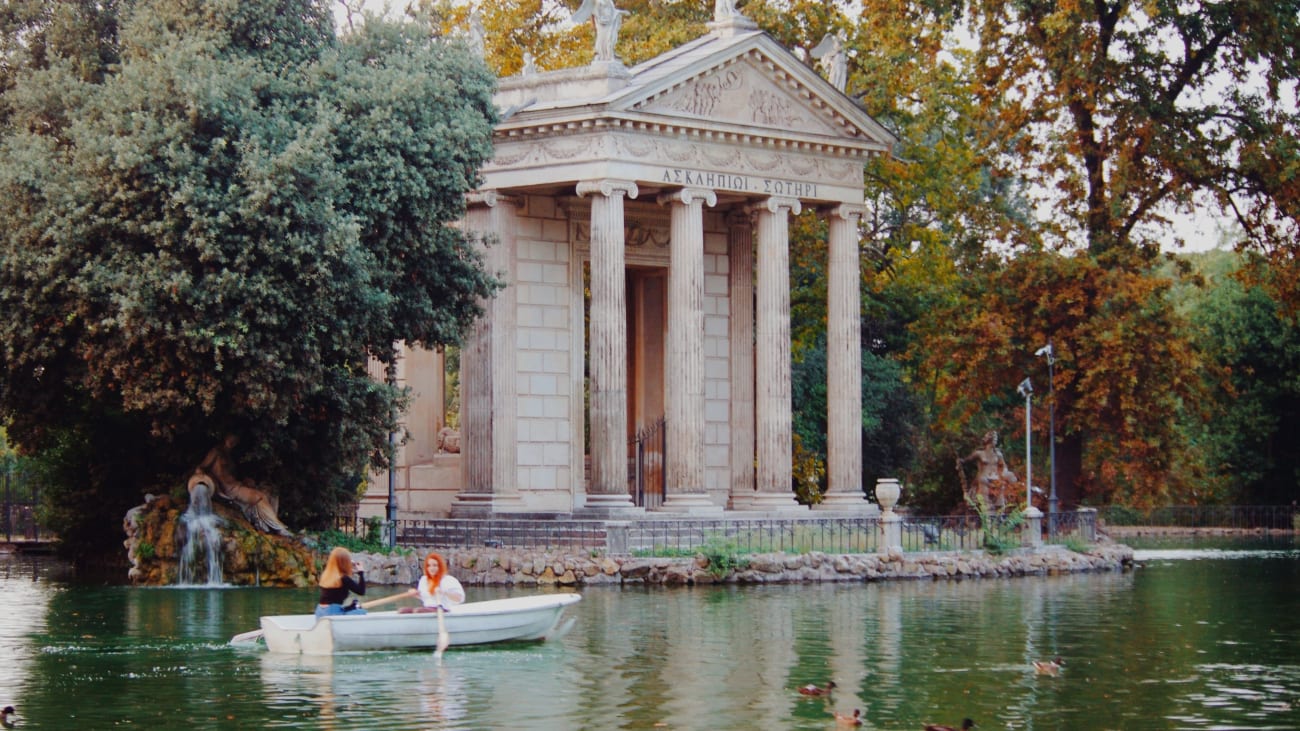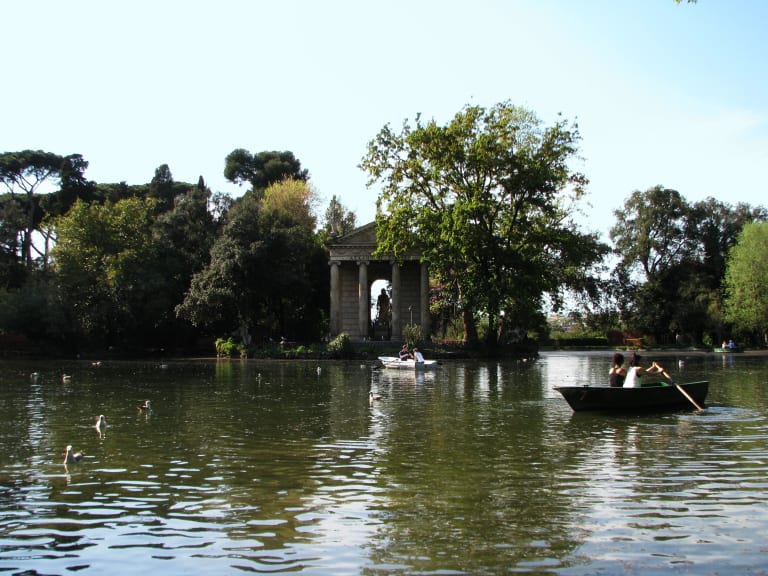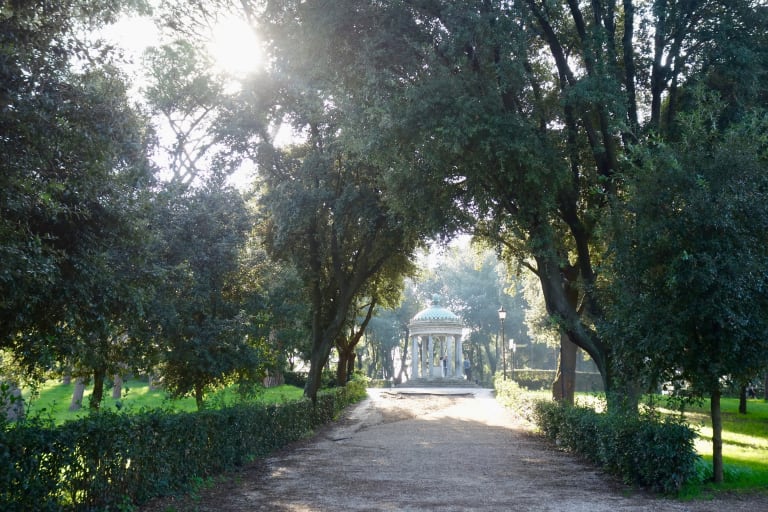What to See and Do in the Gardens of Villa Borghese
The Villa Borghese gardens in Rome are one of the largest urban parks in Europe. Its attraction is that it includes different styles, from the Italian style of its gardens to the English style of its monuments.

Villa Borghese in Rome | ©Marina Gr
The Villa Borghese gardens are one of the best parks in the city of Rome. In 1901, the State acquired the gardens from the Borghese family due to a bad economic situation they were going through and it was opened to the public on July 12, 1903.
Here is what you can see and do in the Villa Borghese gardens if you are planning to visit Rome. This large park is different from other iconic parks because of its harmonious combination of nature and Roman art. Take note and consult this map of the gardens to locate all the enclaves that I recommend.
The 9 entrances to the Villa Borghese gardens

If you want to visit this great park, you should know that it has 9 entrances. The most frequented by visitors are the following:
- The Porta Pinciana, which is one of the ancient gates of the Aurelian walls of Rome.
- The Rampe del Pincio from Piazza del Popolo, through which you can reach the Pincio terrace. From there you can enjoy the most spectacular views of the city of Rome.
- The monumental entrance of Piazzale Flaminio.
Once inside the park you will be fascinated by its gardens and leafy trees that simulate a wild nature.
The heart of Rome and its 80 hectares

Another thing I would like to tell you is that this park has large open spaces where it is possible to do any activity and sport.
First of all, if you love walking, this great park gives you the opportunity to walk through all the areas while enjoying the landscape, fountains and historical monuments of baroque, neoclassical and ecclesiastical artists and, above all, the fascinating sculptures of Villa Borghese.
If you want to tour most of the park in a day, you also have the possibility to rent bicycles for one person, for the family, segways and even small electric cars. There is even a small train, which is an excellent option, as you can rest on it while you get to know the area. The ride takes about 35 minutes and costs around 3€.
The fountain of the sea horses

The design is the work of Cristoforo Unterperger, a painter of Tyrolean origin, which Pope Pius VI Brashi held in high esteem. Its realization was by Vincenzo Pacetti, restorer and sculptor trusted by Marcantonio.
Inside a circular tank on the floor, you can see four horses with fish bodies, which hold above another tub while other water fountains flow through their legs and tails.
Rent a boat

Arriving at the magical garden of the lake you have the possibility to rent boats and take a close look at the temple dedicated to Aesculapius, built at the end of the 18th century. For the Romans, Aesculapius was the god of medicine and healing.
The cost of renting a boat is around 4€ for adults and 2€ for children (minimum 2 persons). Allowing you to paddle on the lake for about 20 minutes, which is well worth it.
Pincio's water clock

In one of the ponds, stands in the middle a clock example of nineteenth-century engineering. It was built in 1867 by Giambattista Embriaco, a Dominican priest with a passion for watchmaking, and the Swiss architect Joachim Ersoch. Today it is fully operational.
The Borghese Gallery

The Borghese Gallery is one of the best museums you can see in Rome. It contains works collected by the Borghese family during the 15th to 17th centuries and created by the best artists of the Renaissance and Baroque periods.
Before visiting this gallery, I recommend you to book your tickets to the Borghese Gallery for a specific day and time to visit, which lasts about 2 hours. In low season you should book your ticket at least one month in advance and in high season, at least 2 months in advance.
Remember that you have only 2 hours to see nothing less than almost four centuries of art. Therefore, my recommendation is that you book a guided tour, so that you can enjoy all the history behind each work of art.
Sculpture of Venus Victrix (Paolina Borghese) By Canova

It was Paolina Bonaparte, the wife of Camillo Borghese, who posed nude for the Italian neoclassical sculptor Antonio Casanova. This sculpture has raised a great stir over the centuries for its beauty and the magnificent details of the sculptor.
You can see the folds of the sheet and the toes, where you can even see her nails. You can even notice the weight of the model on the mattress, among other details impossible to overlook if you admire this impressive work.
Bernini's David

Gian Lorenzo Bernini sculpted his David when he was only 25 years old in 1623. Although it is unfinished at the back, due to the fact that it was originally to be placed attached to a wall, today it is displayed in the center of the room.
This is a very interesting work, as Bernini used a mirror to detail himself (yes, it is a self-portrait) and see the facial expression we see captured in his David.
Apollo and Daphne by Bernini

This sculpture also shows the faithful work of Bernini, who remarked with charcoal the facial expressions of both characters. It shows the delicacy of Apollo's robe and a spectacular realism in the transformation of Daphne's skin into tree bark. Bernini considered Apollo his masterpiece.
Sculpture of the Rape of Proserpina by Bernini

This work is very impressive, as it can be hard to believe that it is a sculpture made of marble because of its incredible realism.
This sculpture tells us the story of Pluto, King of the underworld, and Proserpina, daughter of Jupiter and Ceres. When she is kidnapped, she is forced to live with Pluto, Ceres goes in search of her daughter where they reach an agreement in which Proserpina lives half a year in the underworld and half a year under the sun of her mother.
According to this mythology, therefore, for half a year the earth blooms and in the other half it rains, due to the tears of Ceres waiting for her daughter.
Painting of David with Goliath's Head by Caravaggio

This canvas has quite an interesting history. It happened that Caravaggio ended the life of Ranuccio Tomassoni in a duel. Tomassoni's father was close to Pope Paul V, so the latter, upon learning of what happened, condemned Caravaggio to death. He had to flee to the island of Malta, where, after four years, the Pope decided to pardon him.
On his return to Rome, he was imprisoned in Naples. While there he painted this canvas that he sent to the Pope, where he used his face to represent Goliath decapitated. However, Caravaggio never made it to Rome and his death remains a mystery.
Bioparco, Rome Zoo

This Roman zoo inside the Villa Borghese houses more than 1,000 animals and 200 different species, including felines, chimpanzees, bears, among others. It also has a large botanical exhibit.
It is one of the oldest zoos in Europe. It was established in 1908 and was created by Carl Hagenbeck, who sought to design a different zoo. The structure allows the animals to reside freely without being enclosed in cages, maintaining a clear division with the public.
Silvano Toti Globe Theatre

The creation of the Silvano Toti Globe Theatre was made possible by the Silvano Toti Foundation, an association that was created by the Toti family to honor Silvano's memory. Some consider it a copy of Shakespeare's Globe Theatre in London.
Recommendations for visiting the Villa Borghese

Here is what I consider to be the most important things to keep in mind when visiting this park:
- It is a fairly large park and if you plan to walk around it is very important that you wear the right footwear and that it is comfortable.
- You should also bring a bottle of water.
- Bring cool clothes if you go in summer, as it can be quite hot.
- If you want to enhance your experience, you can plan your trip to Villa Borghese in the evening. This will give you the opportunity to enjoy truly spectacular views of Rome's skyline across the gardens and the Pincio terrace.
- Get a map, this will help you navigate the gardens more easily and direct you to the attractions that catch your eye.
- There are few public restrooms in the garden, but if it is urgent, you can go to the one inside the Borghese Gallery if you have purchased a ticket.
- Although there are food options in the park, you can have a picnic under its groves.
Recommendations if you go with children

You should take into account all the recommendations I left you in the previous segment, especially that of bringing water, since the little ones have inexhaustible energy and they will need to hydrate themselves.
The park allows you to play sports and games, so you can bring a ball, racquets or any other sporting instrument for them to play with.
Finally, if you have bought your tickets to enter the Borghese Gallery, you can take your children to the San Carlino puppet theater. This show features Pulcinella, a popular puppet character that was created in Naples. This attraction was designed to entertain the little ones while the adults view the art gallery.
Both in this wonderful park and throughout Rome there are many activities you can plan with your children. So, I want to invite you to read my guide on 10 things to do in Rome with kids
General information about the Villa Borghese

- How to get there: you can take the bus, streetcar or metro. If you decide to take the subway you can read the following guide to the subway in Rome Outside the park there are several stops from where you can get off and simply walk to any of the entrances.
- Address: Piazzale Napoleone I, 00197 Roma RM, Italy.
- Entrance fee: admission is free. However, you must pay to enter attractions such as the Borghese Gallery.
- Hours: the gardens are open Monday to Friday, all day, until sunset.
- When is the best time to go: if you want to go when it is less crowded, you can go early in the morning or in the evening.
If you want to visit Rome at some point, or are already planning everything, I hope you have a happy vacation! Enjoy all the history and sights you will find there.
